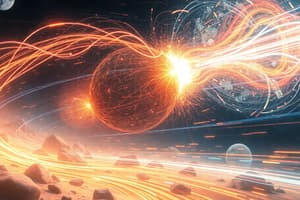Podcast
Questions and Answers
What is the relationship between work and energy according to the work-energy theorem?
What is the relationship between work and energy according to the work-energy theorem?
- Work done equals the change in kinetic energy (correct)
- Work and energy are unrelated concepts
- Work done is inversely proportional to energy
- Energy is equal to the work done
In rotation, what is the role of torque?
In rotation, what is the role of torque?
- Torque is the same as force
- Torque is unrelated to rotation
- Torque multiplies angular acceleration by the moment arm (correct)
- Torque determines the speed of rotation
Which type of motion is characterized by a restoring force directly proportional to displacement?
Which type of motion is characterized by a restoring force directly proportional to displacement?
- Simple Harmonic Motion (SHM) (correct)
- Linear motion
- Uniform circular motion
- Random motion
What aspect of fluids does fluid mechanics study?
What aspect of fluids does fluid mechanics study?
What does the center of mass represent in a system of particles?
What does the center of mass represent in a system of particles?
Which type of energy is associated with motion?
Which type of energy is associated with motion?
What is the focus of kinematics?
What is the focus of kinematics?
Which quantity does velocity describe?
Which quantity does velocity describe?
According to Newton's first law of motion, what happens to an object at rest?
According to Newton's first law of motion, what happens to an object at rest?
Which equation represents Newton's second law of motion?
Which equation represents Newton's second law of motion?
What is the relationship between work and energy?
What is the relationship between work and energy?
In physics, what is the role of center of mass?
In physics, what is the role of center of mass?
Study Notes
Exploring the World of Physics
Physics is a fascinating and expansive field that aims to understand the natural world through observation, experimentation, and mathematical modeling. In this exploration, we'll dive into a few key subtopics to get a taste of the breadth and depth of this subject.
Kinematics
Kinematics is the study of the motion of objects without regard to the forces that produce that motion. In other words, it focuses on describing the behavior of objects as they move, without considering what makes them move. Topics in kinematics include:
- Position and displacement: Where an object is in space and how far it has moved.
- Velocity: The rate at which an object's position changes, represented in terms of magnitude and direction.
- Acceleration: The rate at which an object's velocity changes, also with magnitude and direction.
Laws of Motion
Based on observations and experiments, Sir Isaac Newton introduced three laws of motion. These laws lay the foundation for a deeper understanding of how objects interact with one another.
- Law 1: An object at rest tends to stay at rest, and an object in motion tends to stay in motion with the same speed and direction unless acted upon by an unbalanced force.
- Law 2: Force is equal to mass times acceleration (F=ma).
- Law 3: For every action, there is an equal and opposite reaction (Newton's third law).
Work and Energy
Work and energy are interconnected concepts. Work is the force applied to an object in the direction of its motion, while energy is the ability to do work. In physics, two major types of energy are kinetic (energy of motion) and potential (stored energy). Work and energy are related through the work-energy theorem: The work done on an object equals the change in its kinetic energy.
Rotation
Rotation is the movement of an object around a fixed axis. Topics related to rotation include angular displacement, angular velocity, angular acceleration, and torque, which is the rotational equivalent of force. Torque multiplies angular acceleration by the moment arm, an imaginary line perpendicular to the axis of rotation and passing through the point where the force is applied.
Simple Harmonic Motion (SHM)
SHM is a special form of periodic motion where the restoring force is directly proportional to the displacement and acts in the opposite direction. It's also characterized by the property that the restoring force is always directed toward the equilibrium position. Examples of SHM include the motion of a mass attached to a spring and the motion of a pendulum.
Fluid Mechanics
Fluid mechanics is the study of fluids in motion. It's a vast subfield with applications ranging from weather prediction to hydrodynamic engineering. Topics in fluid mechanics include fluid statics, fluid dynamics, and fluid transport.
Center of Mass
The center of mass (COM) is the point where the mass of an object can be considered concentrated. The COM of a system of particles is the point at which the system's mass can be considered concentrated, and it follows a trajectory similar to that of the system's center of mass.
Physics is a fascinating subject that covers a broad range of topics, and the topics listed here are just a small subset. But, as you explore these concepts and learn more, you'll begin to see the connections between them and gain a deeper understanding of our natural world.
Studying That Suits You
Use AI to generate personalized quizzes and flashcards to suit your learning preferences.
Description
Dive into the world of physics by exploring key concepts such as kinematics, laws of motion, work and energy. Learn about the motion of objects, Newton's laws, the relationship between work and energy, and more. Expand your understanding of the natural world through observation, experimentation, and mathematical modeling.




